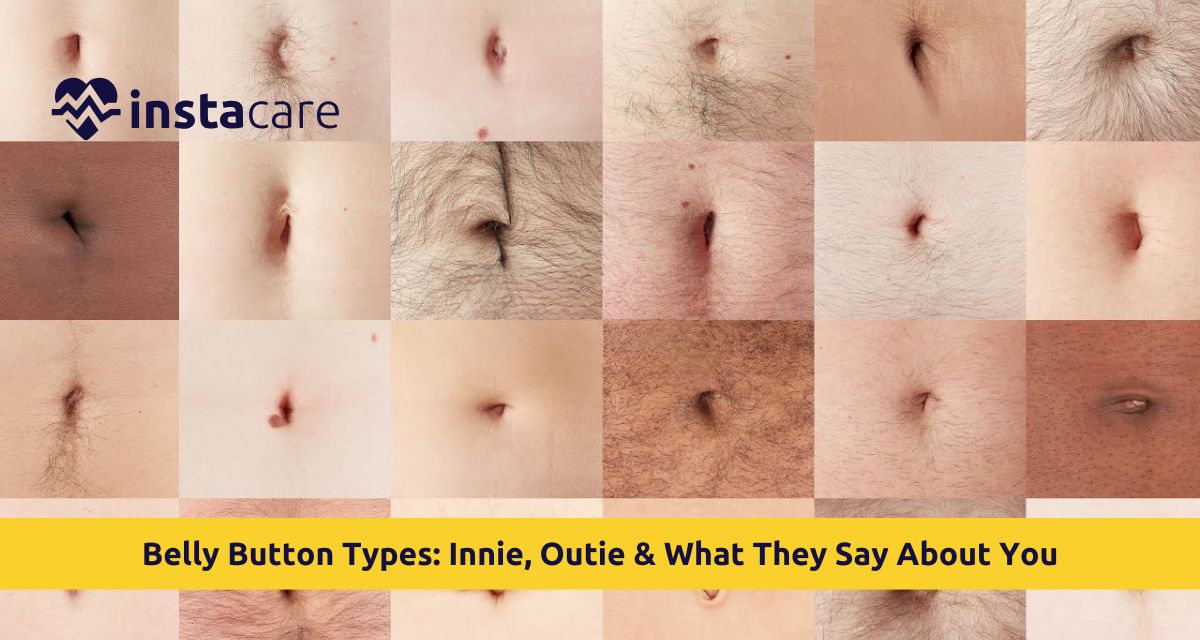What is a Belly Button?
A navel, belly button, or umbilicus, is a scar after the time when your umbilical cord was cut off after you were born. Your umbilical cord had been attached to you from your mother while you were in the womb and providing you with food and oxygen. When you are born, medical professionals clamp and cut the cord, which will be what your belly button is.
Your belly button anatomy is very basic. It consists of skin and scar tissue that create a small bump or indentation on the middle of your tummy. Your belly button appearance changes are established by a thousand different factors, such as how your umbilical cord was sliced, how your belly had healed, your genetics, and the shape of your body.
Something you probably don't realize is that belly buttons are actually the middle of your body. They represent the place where you were connected to your mother, so they're important medically and poetically as well.
Main Types of Belly Buttons
Physicians and researchers have counted up several common belly button types. Knowing the different types of belly buttons will allow you to determine what type you have.
Innie vs Outie Belly Button - Innie Belly Buttons
Approximately 90% of people possess innie belly buttons. This is among the most common belly button types, and this is when your navel folds in to create a small pit or
depression on your abdomen. Innie belly buttons can be shallow or deep and oval or circular in their belly button shapes.
The extent of an innie can also vary a lot. Some are hardly indented, and others produce a big indentation. It also becomes distorted over your lifetime with weight gain or loss, pregnancy, or just usual aging, contributing to belly button appearance changes.
Innie vs Outie Belly Button - Outie Belly Buttons
Fewer than about 10% of people have outie belly buttons, making them among the rare belly button types. These bulge out from your stomach instead of curving inward toward it. An outie isn't a result of the manner in which your physician cut your umbilical cord, contrary to a common myth. The causes of outie belly button development occur due to the gap between your stomach muscles, the length of your umbilical cord, and how much excess umbilical cord remained after being trimmed.
Round Belly Buttons
Round belly buttons are circular belly button shapes and are typically very deep. This should probably be among the most common belly button types and what the majority would define as being the "perfect" shape.
Oval Belly Buttons
Oval belly button shapes are wider than they are tall, in an egg shape. This is also very universal among common belly button types and can be an innie vs outie belly button variation.
Deep Belly Buttons
Some people have very deep belly button shapes, which create a deep concavity in the belly. These are perhaps more troublesome to clean and have perhaps another thick layer of fluff and lint building up inside, requiring specific belly button hygiene tips.
Shallow Belly Buttons
Shallow belly button shapes have only a shallow depression. They consist of simpler types of belly buttons but could be less noticeable than deeper varieties.
Protruding Belly Buttons
These appear to be outies but protrude more, representing rare belly button types. This is sometimes linked with such ailments as belly button hernia.
What Does Your Belly Button Say About You
Though there is no scientific evidence that belly button shapes will tell us about personality, there have been some interesting guesses by several cultures as to what belly buttons might mean.
Cultural Beliefs and Folklore
Some of the beliefs in the world view round and deep belly button shapes as making one trustworthy and reliable. Oval belly button shapes are usually linked with creativity, natural talent and imagination. Outie navels in some myths are linked with leadership and confidence, adding to the mystery of what does your belly button say about you.
Body Language and Confidence
There are some people who are more or less self-assured based on their navel. Those who have an innie navel are less self-conscious about doing crop tops or bikinis, while those who have an outie navel feel conscious about how they appear, affecting considerations for belly button piercings and types.
Modern Perspectives
Today, the majority of health care practitioners agree that your belly button shapes really do not say much about your personality, health, or destiny. It's simply a matter of how your umbilical cord closed during birth, as well as your individual belly button anatomy.
Embracing Your Unique Type
The most important thing to understand is that all types of belly buttons are totally normal and natural. Regardless of whether you are dealing with innie vs outie belly button variations, or maybe a little bit of both, your belly button belongs to you and only you.
Belly Button and Health Insights
While your belly button shapes won't predict your personality, there are some real belly button health issues to keep in mind when it comes to the different types of belly buttons.
Normal Belly Button Health Issues
Belly button infections may happen in any navel, but inner innies tend to harbor more bacteria unless they follow proper belly button hygiene tips. Belly button infections may cause redness, inflammation, discharge, and smell.
Belly Button Hernia
A belly button hernia, or an umbilical hernia, will cause your belly button to bulge or even distort. It happens when some of your intestine bulges through a weak area of muscle in your abdominal wall around your belly button. Although it can happen to any person with any types of belly buttons, it is more visible on individuals who have innies naturally.
Belly Button Appearance Changes
Your navel can experience belly button appearance changes throughout your lifetime. Pregnancy will typically result in temporary changes because your tummy expands.
Weight gain or loss might also change belly button shapes. Aging skin elasticity changes might make navel appearances vary over a period of time.
When to See a Doctor
You need to see a doctor if you notice sudden belly button appearance changes, frequent pain, discharge, smells, or infections. These are symptoms of underlying belly button health issues that should be treated.
Belly Button Surgery
Others choose to have belly button surgery, or umbilicoplasty, to change their belly button shapes. This cosmetic belly button surgery can turn an outie into an innie or relocate the belly button. Again, as with all surgery, risks exist and they must be weighed carefully.
Belly Button Hygiene Tips
Good navel hygiene must be practiced by all, independent of your types of belly buttons. Below are some easy belly button hygiene tips for maintaining a clean and healthy navel.
Daily Cleaning Routine
Shower and wash the navel daily as part of your belly button hygiene tips. Rinse the region with soap and water and then wash with your finger or a soft washcloth. Scrub a little harder on more recessed navels to help remove any soap residue, dead skin cells, or lint.
Drying Thoroughly
After you wash your belly button, dry it completely according to proper belly button hygiene tips. Water in the belly button is where bacteria or a fungus begins, potentially leading to belly button infections. Dry the area with a towel, and in deeper recessed belly button shapes, you can attempt to remove all the water with a cotton swab.
Dealing with Belly Button Lint
Navel lint is totally natural and results from hairs on clothing becoming tangled in your navel. Following regular belly button hygiene tips will stop a lot of it from piling up, but if you do find you have too much, you can gently brush it away with a wet cotton bud.
Belly Button Piercings and Types Care Considerations
If you are thinking about belly button piercings and types, and what to wear, consider that different types of belly buttons affect the healing and appearance of piercings. Outies or shallow belly button shapes may be less than ideal for routine belly button piercings and types. Make sure to sit down with an experienced piercer who will be able to check your own belly button anatomy.
Signs of Problems
Search for warning signs: persistent odors, unusual discharge, pain, redness, or swelling. They could be an indication of belly button infections or other belly button health issues to present to a doctor. Those with bigger navel or deep belly button shapes will have to go the extra distance to clean thoroughly and dry thoroughly following belly button hygiene tips. Those who have outie belly button shapes will need to take care not to scrub relatively exposed skin when bathing.
Conclusion
Your belly button is a fascinating aspect of your belly button anatomy that reveals a great deal about your very first connection with life. Being part of the innie vs outie belly button debate, or one of the rare belly button types, is a completely normal and natural aspect of being you. While belly button shapes do not actually have that great an influence in terms of personality or health, by understanding the different types of belly buttons, you can find out more about what does your belly button say about you and how to better care for it with proper belly button hygiene tips.
Remember that every types of belly buttons are healthy ones, and there's no "better" or "worse" among common belly button types to have. The most important thing is to follow belly button hygiene tips, avoid belly button health issues, and to love you just the way you are. If you absolutely need to go ahead and ask about belly button appearance changes or sensation of your belly button, then go and speak with a health care provider.
Please book an appointment with the best
General Physician in Lahore, Karachi, Islamabad, and all major cities of Pakistan through
Instacare, or call our helpline at 03171777509 to find a verified doctor for your disease.

